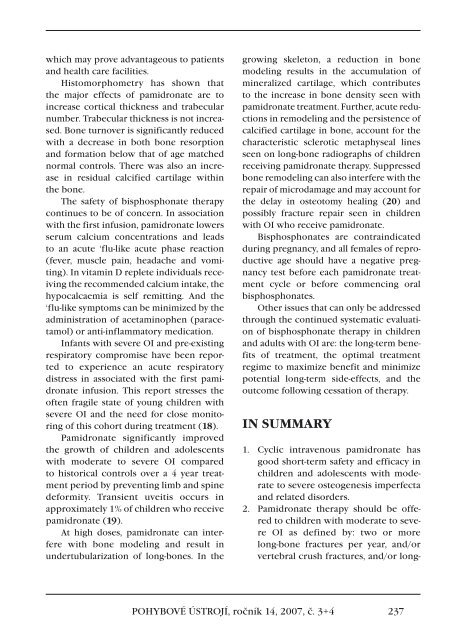Ortopedická protetika Praha sro - Společnost pro pojivové tkáně
Ortopedická protetika Praha sro - Společnost pro pojivové tkáně
Ortopedická protetika Praha sro - Společnost pro pojivové tkáně
Create successful ePaper yourself
Turn your PDF publications into a flip-book with our unique Google optimized e-Paper software.
which may <strong>pro</strong>ve advantageous to patients<br />
and health care facilities.<br />
Histomorphometry has shown that<br />
the major effects of pamidronate are to<br />
increase cortical thickness and trabecular<br />
number. Trabecular thickness is not increased.<br />
Bone turnover is significantly reduced<br />
with a decrease in both bone resorption<br />
and formation below that of age matched<br />
normal controls. There was also an increase<br />
in residual calcified cartilage within<br />
the bone.<br />
The safety of bisphosphonate therapy<br />
continues to be of concern. In association<br />
with the first infusion, pamidronate lowers<br />
serum calcium concentrations and leads<br />
to an acute ‘flu-like acute phase reaction<br />
(fever, muscle pain, headache and vomiting).<br />
In vitamin D replete individuals receiving<br />
the recommended calcium intake, the<br />
hypocalcaemia is self remitting. And the<br />
‘flu-like symptoms can be minimized by the<br />
administration of acetaminophen (paracetamol)<br />
or anti-inflammatory medication.<br />
Infants with severe OI and pre-existing<br />
respiratory com<strong>pro</strong>mise have been reported<br />
to experience an acute respiratory<br />
distress in associated with the first pamidronate<br />
infusion. This report stresses the<br />
often fragile state of young children with<br />
severe OI and the need for close monitoring<br />
of this cohort during treatment (18).<br />
Pamidronate significantly im<strong>pro</strong>ved<br />
the growth of children and adolescents<br />
with moderate to severe OI compared<br />
to historical controls over a 4 year treatment<br />
period by preventing limb and spine<br />
deformity. Transient uveitis occurs in<br />
ap<strong>pro</strong>ximately 1% of children who receive<br />
pamidronate (19).<br />
At high doses, pamidronate can interfere<br />
with bone modeling and result in<br />
undertubularization of long-bones. In the<br />
growing skeleton, a reduction in bone<br />
modeling results in the accumulation of<br />
mineralized cartilage, which contributes<br />
to the increase in bone density seen with<br />
pamidronate treatment. Further, acute reductions<br />
in remodeling and the persistence of<br />
calcified cartilage in bone, account for the<br />
characteristic sclerotic metaphyseal lines<br />
seen on long-bone radiographs of children<br />
receiving pamidronate therapy. Suppressed<br />
bone remodeling can also interfere with the<br />
repair of microdamage and may account for<br />
the delay in osteotomy healing (20) and<br />
possibly fracture repair seen in children<br />
with OI who receive pamidronate.<br />
Bisphosphonates are contraindicated<br />
during pregnancy, and all females of re<strong>pro</strong>ductive<br />
age should have a negative pregnancy<br />
test before each pamidronate treatment<br />
cycle or before commencing oral<br />
bisphosphonates.<br />
Other issues that can only be addressed<br />
through the continued systematic evaluation<br />
of bisphosphonate therapy in children<br />
and adults with OI are: the long-term benefits<br />
of treatment, the optimal treatment<br />
regime to maximize benefit and minimize<br />
potential long-term side-effects, and the<br />
outcome following cessation of therapy.<br />
IN SUMMARY<br />
1. Cyclic intravenous pamidronate has<br />
good short-term safety and efficacy in<br />
children and adolescents with moderate<br />
to severe osteogenesis imperfecta<br />
and related disorders.<br />
2. Pamidronate therapy should be offered<br />
to children with moderate to severe<br />
OI as defined by: two or more<br />
long-bone fractures per year, and/or<br />
vertebral crush fractures, and/or long-<br />
POHYBOVÉ ÚSTROJÍ, ročník 14, 2007, č. 3+4 237

















